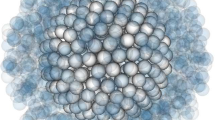Abstract
The world is filled with various scales of particles from subatomic to astronomical stars (nebulosity), while each type of particle will be flexible and deform time-dependently. Some previous researches based on stochastic momentum equation including immersed mass effect and quasi-stability principle, which is the weakest stability principle, lead to clarification of the various size ratios of biological particles and those appearing in breaking up of abiological particles having lifetime, while especially revealing the bi-modal frequency distribution around about 2:3 close to golden–silver ratio and 1:1 of Yamato ratio for particle pair sizes (Naitoh in Artif Life Robot 18:133–143, 2013; Kobayashi and Naitoh in J Adv Simul Sci Eng 6(1):80–93, 2019). It should also be stressed that traditional theories stated by Bohr with energy conservation law cannot predict the bi-modal distribution of about 2:3 and 1:1. In this report, the size ratios seen in the stabler particles having longer lifetime than that of unstable particles like super-heavy elements having very short lifetime, i.e., description of size ratios seen in stabler atoms like Ne, Ar, Kr, Xe, and Rn in periodic table, are revealed by considering the frequency distribution of the quasi-stable ratios based on a new “mostly neutral” stability principle between the weakest stability (quasi-stability) proposed by the authors and the neutral stability known well in fluid dynamics.





Similar content being viewed by others
Data availability
The datasets generated during and/or analysed during the current study are available from the corresponding author on reasonable request.
References
EL-WAKIL MM (1971) Nuclear heat transport. DoubunShoin
Henley EM, Garcia A (2007) Subatomic physics. World Scientific, Singapore
Naitoh K (2001) Cyto-fluid dynamic theory. Jpn J Ind Appl Math 18(1):75–105
Kobayashi T, Naitoh K (2019) New quasi-stable ratios of particles in nature revealed by multi-dimensional Taylor approximation. J Adv Simul Sci Eng 6(1):80–93
Naitoh K (2013) Gourdron theory: revealing synthetically the masses for biological molecular particles of DNA and proteins and abiological particles of quarks and leptons. Artif Life Robot 18:133–143
Bohr N, Wheeler JA (1939) The mechanism of nuclear fission. Phys Rev 56:426–450
Kobayashi T, Naitoh K (2020) Relation between child atom sizes and input neutron energy clarified by a stochastic momentum equation and quasi-stability principle (in Japanese). Trans Jpn Soc Simul Technol 12(2):54–58
Tatsumi T (1982) Fluid dynamics. Baifukan, Tokyo
Ghorpade SR, Limaye BV (2010) A course in multivariable calculus and analysis. Springer, Berlin
Miley GH, Patterson JA (1996) Nuclear transmutations in thin-film nickel coatings undergoing electrolysis. J New Energy 1(3):5–30
Crouch EAC (1977) Fission-product yields from neutron-induced fission. At Data Nucl Data Tables 19:417–532
Naitoh K (2014) Instantaneous and scale-versatile gourdron theory: pair momentum equation, quasi-stability concept, and statistical indeterminacy revealing masses of elementary, bio-molecular, and cosmic particles. J Phys Conf Ser 495:012016
Acknowledgements
This work was supported by Grant-in-Aid for JSPS Fellows (21J21973).
Author information
Authors and Affiliations
Corresponding author
Additional information
Publisher's Note
Springer Nature remains neutral with regard to jurisdictional claims in published maps and institutional affiliations.
Appendix
Appendix
The equation of Newton and Navier–Stokes equation can predict the physical processes for a long time, while the applicable range of scale is limited. On the other hand, the present theory can be applied for phenomena in a wide range of scales, although describing only around breakup timing.
There are so many approaches, which try to find the universal theory describing temporal history of physical phenomena from subatomic to cosmic systems, i.e., four-dimensional (unsteady three-dimensional) feature. [1, 2]
However, one of our most important targets is to know the masses of various particles in the universe. Thus, we think about the most important timing at which masses are determined. The important timing is rate-determining step, just before breakup. [3,4,5]
Let us think about the shape of particle just before breakup for various cases including subatomic, bio-molecular, and cosmic particles. The common shape will be like gourd, which has two sphere-like or spheroid-like particles connected.
Therefore, the previous models based on gourd shape assumption [3,4,5] show a large possibility describing the masses of various particles in the universe.
About this article
Cite this article
Kobayashi, T., Naitoh, K. The weakest stability theory for stochastic momentum equation: revealing the sizes in biological and abiological particles. Artif Life Robotics 28, 8–14 (2023). https://doi.org/10.1007/s10015-022-00841-z
Received:
Accepted:
Published:
Issue Date:
DOI: https://doi.org/10.1007/s10015-022-00841-z




